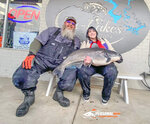

HOOD OUTDOORS
As a licensed professional fishing guide, Michael Acosta shows you how to find them. A Granbury resident of more than 35 years, he has been fishing all of his life, and has been a licensed guide since 1998.
Tis the season for catching big bass all across the south. Between now and through the spawning season is the best-known time where your chances are better to catch a really big largemouth bass. In fact, most ShareLunker fish (13-plus pounds) are caught during the late winter and early spring, but bass anglers are not the only anglers looking for big fish this time of the year (Texas Parks and Wildlife ShareLunker program typically runs from October to April.
Why is this season typically better for big fish? Well most agree that the bigger fish (large females) tend to feed more actively prior to the spawn. We know this to be true. This goes for all species and not just bass. Winter fish continue to feed easily due to the baitfish being lethargic and are already busting at the seams as spring spawning season approaches. With the warming waters the fish continue to get more active due to water temperatures increasing as well as feeding up for the spawn.
Fish will weigh heavier in the late winter and spring as I alluded to above. Both males and females are full of eggs/silt as well as having unbelievable amounts of fat stored during their fall and winter season gorging.
For those of you fishing for stripers, hybrids and sand bass, this is a great time to keep some of these fish for the table. These fish are extremely healthy this time of the year and they will really filet up nice.
This is also a great time for catch and release for all species. With water temperatures below 60 degrees, the survival rate for released fish is extremely good as long as the fish is not deeply hooked. In the summer when mortality rates are high, you should keep your limit and then refrain from catching any more of that species.
Catching and releasing stripers and hybrids in the dead of summer can be lethal. Many will say that to protect the fishery it is best to keep your limit and don’t catch and release. One option if you still want to fish after keeping a limit of hybrids and stripers in the summer is to go look for another species such as sand bass or crappie.
Currently I have been catching bigger fish off of deep structure (around 30 to 40 feet down) on many reservoirs. Water temperatures are in the upper 40s, but are sure to rise in the near future. The smaller fish have been tending to be grouped in bigger schools near baitfish concentrations in deep open water.
Each day on the water is a new adventure, so be prepared to change. I would recommend a little scouting on the water if you had not been out in a while. Even one day may change patterns. Right now I would use my graph to determine the depth that the majority of baitfish are located.
One this depth is known, go to dropoffs, ledges and such that you know about and work those same depths. The bigger fish are typically right off these humps and ridges and will move up near to or on the humps and ridges to feed. As the water warms in the next few weeks, the depths where the baitfish are holding may change and working shallower humps may be in order. Just keep your options open and trust your graph. If the birds are working, I like to work under the active fish coming up hoping to up with the bigger fish that are typically below.
As anglers we are always looking forward to when that big fish bites. That is what it is all about. Get on the water this late winter and spring and put that trophy in the boat. Your chances will be better.
HOOD COUNTY FISHING REPORT
Granbury water temperatures are rebounding to the upper 40s to low 50s. Largemouth bass numbers are good near deeper docks and near dropoffs on soft plastics worked slow. Crappies are good on small jigs fished on deeper structure from DeCordova to the Peninsula. Striped bass continue to be good to 12 pounds on jigs and shad fished from Indian Harbor to The Shores. Blue catfish to 56 pounds are possible on cut bait. A potential new lake record blue catfish weighing 56.56 pounds was caught by Personal Best Guide Service this last weekend. Sand bass action is good in deeper water by the Peninsula where the fish are staging for their spawning effort and some good reports of sand bass being caught near Tin Top.
OTHER AREAS
Comanche Creek reservoir continues to boast on limits of largemouth bass and channel catfish. Anglers line up to get on this reservoir when it is open (Thursday – Sunday).
On other reservoirs, Lake Whitney and Possum Kingdom Lake striped bass action continues to be excellent on jigs and live bait. Whitney action is best from McCown Valley north. Possum Kingdom striped bass are good from the Peanut Patch to the Island.
michael.acosta@att.net | 254-396-4855